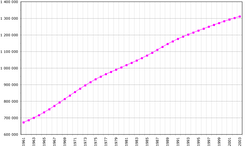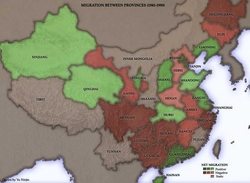
| - People - |
Population
Contents

Population: 1,298,847,624 (July 2004 est.)
Age structure:
0-14 years: 22.3%
(male 153.4 million; female 135.8 million)
15-64 years: 70.3%
(male 469.3 million; female 443.3 million)
65 years and over: 7.5%
(male 46.3 million; female 50.8 million)
(2005 est.)
Median age:
total: 31.8 years
male: 31.5 years
female: 32.2 years (2004 est.)
Population growth rate:
Overall: 0.57%
Birth rate: 12.98 births/1,000 population
Death rate: 6.92 deaths/1,000 population
Net migration rate: -0.4 migrant(s)/1,000 population
(2004 est.)

Sex ratio:
at birth: 1.12 male(s)/female
under 15 years: 1.13 male(s)/female
15-64 years: 1.06 male(s)/female
65 years and over: 0.91 male(s)/female
total population: 1.06 male(s)/female (2004 est.)
Infant mortality rate:
total: 25.28 deaths/1,000 live births
male: 21.84 deaths/1,000 live births
female: 29.14 deaths/1,000 live births (2004 est.)
Life expectancy at birth:
total population: 71.96 years
male: 70.4 years
female: 73.72 years (2004 est.)
Total fertility rate: 1.69 children born/woman (2004 est.)

With a population of over 1.3 billion and an estimated growth rate of 0.57%, the PRC is very concerned about its population growth and has attempted with mixed results to implement a strict family planning policy. The government's goal is one child per family, with exceptions in rural areas and for ethnic minorities. Official stated government policy opposes forced abortion or sterilization, but allegations of coercion continue as local officials strive to meet population targets. The government's goal is to stabilize the population and population growth early in the 21st century, although some current projections estimate a population of anywhere ranging from 1.4 billion to 1.6 billion by 2025.
noun: Chinese (singular and plural)
adjective: Chinese
The People's Republic of China (PRC) officially recognizes 56 distinct ethnic groups, the largest of which are Han Chinese, who constitute about 91.9% of the total population. Large ethnic minorities include the Zhuang (16 million), Manchu (10 million), Hui (9 million), Miao (8 million), Uighur (7 million), Yi (7 million), Tujia (5.75 million), Mongolian (5 million), Tibetan (5 million), Buyi (3 million), and Korean (2 million).
According to official reports, the definition of literacy is anyone age 15 and over who can read and write 1500 characters or more.
total population: 90.9%
male: 95.1%
female: 86.5% (2002)
Other studies indicate the official numbers are inflated and otherwise inaccurate and report a 50% literacy rate.
The Chinese world or Chinese cultural world is an expression used for a group of East Asian countries/ dependencies/ territories and the well established overseas Chinese communities across the world (Chinese diaspora) linked to mainland China because they are widely influenced by the Chinese culture.
The Chinese world is considered to be made up of:
Using these estimates, the Chinese world population totals 1,369,451,000- 1,374,451,000 (1.369- 1.374 billion), or about 20% of the entire world's population.
The Chinese world as a cultural notion, is shown to have strongly influenced some foreign cultures, such as Japanese (population of 120 million), Korean (combined population of 70 million), Vietnamese (population of 80 million), and Mongolian (population of 2.5 million). Using these figures, combined with those above, it can be said that the Chinese cultural world consists of between 1,641,951,000 and 1,646,951,000 (1.642- 1.647 billion) people worldwide.
Size and Distribution of Minority Nationalities in China
| Minority Nationality | Approximate Population | Major Areas of Distribution |
|---|---|---|
| Zhuang | 13,400,000 | Guangxi-Zhuang Autonomous Region; Yunnan, Guangdong, Guizhou provinces |
| Hui | 7,200,000 | Ningxia-Hui Autonomous Region; Gansu, Henan, Qinghai, Yunnan, Hebei, Shandong provinces; Xinjiang-Uygur Autonomous Region |
| Uygur | 6,000,000 | Xinjiang-Uygur Autonomous Region; Hunan Province |
| Yi | 5,500,000 | Yunnan, Sichuan, Guizhou provinces; Guangxi- Zhuang Autonomous Region |
| Miao | 5,000,000 | Guizhou, Hunan, Yunnan, Sichuan provinces; Guangxi-Zhuang Autonomous Region |
| Manchu | 4,300,000 | Liaoning, Heilongjiang, Jilin, Hebei provinces; Nei Monggol Autonomous Region; Beijing Municipality |
| Zang (Tibetan) | 3,800,000 | Xizang Autonomous Region; Sichuan, Qinghai, Gansu provinces |
| Monggol | 3,400,000 | Nei Menggu Autonomous Region; Liaoning Province; Xinjiang-Uygur Autonomous Region |
| Tujia | 2,800,000 | Hubei, Hunan, and Sichuan province |
| Bouyei | 2,100,000 | Guizhou Province |
| Korean | 1,800,000 | Jilin, Heilongjiang, and Liaoning provinces |
| Dong | 1,400,000 | Guizhou, Hunan provinces; Guangxi-Zhuang Autonomous Region |
| Yao | 1,400,000 | Guangxi-Zhuang Autonomous Region; Hunan, Yunnan, Guangdong provinces |
| Bai | 1,100,000 | Yunnan Province |
| Hani | 1,100,000 | N/A |
| Kazak | 900,000 | Xinjiang-Uygur Autonomous Region |
| Li | 890,000 | Guangdong, Guizhou provinces |
| Dai | 840,000 | Yunnan Province |
| Lisu | 480,000 | N/A |
| She | 370,000 | Fujian, Zhejiang provinces |
| Lahu | 300,000 | Yunnan Province |
| Va | 300,000 | N/A |
| Shui | 290,000 | Guizhou Province |
| Dongxiang | 280,000 | Gansu Province, Xinjiang-Uygur Autonomous Region |
| Naxi | 250,000 | Yunnan Province |
| Tu | 160,000 | Qinghai Province |
| Kirgiz | 114,000 | Xinjiang-Uygur Autonomous Region |
| Qiang | 100,000 | Sichuan Province |
| Daur | 95,000 | Nei Menggu Autonomous Region; Heilongjiang Province |
| Jingpo | 93,000 | Yunnan Province |
| Mulao | 90,000 | Guangxi-Zhuang Autonomous Region |
| Xibe | 84,000 | Liaoning Province; Xinjiang-Uygur Autonomous Region |
| Salar | 69,000 | Qinghai, Gansu provinces |
| Bulang | 58,000 | Yunnan Province |
| Gelao | 54,000 | Guizhou Province |
| Maonan | 38,000 | Guangxi-Zhuang Autonomous Region |
| Tajik | 27,000 | Xinjiang-Uygur Autonomous Region |
| Pumi | 24,000 | Yunnan Province |
| Nu | 23,000 | N/A |
| Achang | 20,000 | N/A |
| Ewenki | 19,000 | Nei Menggu Autonomous Region; Heilongjiang Province |
| Jing | 13,000 | Guangxi-Zhuang Autonomous Region; Guizhou, Guangdong provinces |
| Benglong | 12,000 | Yunnan Province |
| Uzbek | 12,000 | Xinjiang-Uygur Autonomous Region |
| Jinuo | 12,000 | Yunnan Province |
| Yugur | 11,000 | Gansu Province |
| Baoan | 9,000 | N/A |
| Drung | 4,600 | Yunnan Province |
| Tartar | 4,100 | Xinjiang-Uygur Autonomous Region |
| Oroqen | 4,100 | Nei Menggu Autonomous Region; Heilongjiang Province |
| Russian | 2,900 | Xinjiang-Uygur Autonomous Region |
| Gaoshan | 1,700 | Fujian, Guizhou provinces |
| Hezhe | 1,500 | Heilongjiang Province |
| Moinha | 1,140 | Xizang Autonomous Region |
| Lhoba | 1,100 | N/A |
| Other | 800,000 | Guizhou, Yunnan province |
![]()